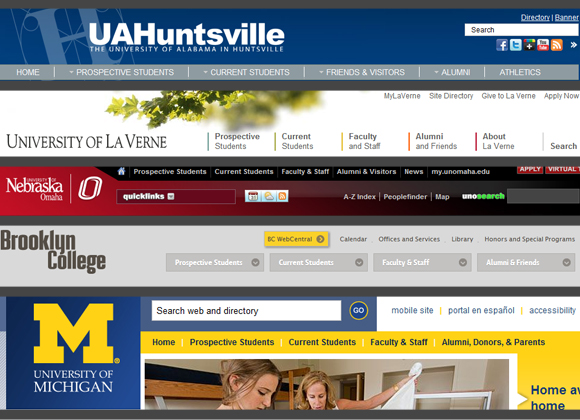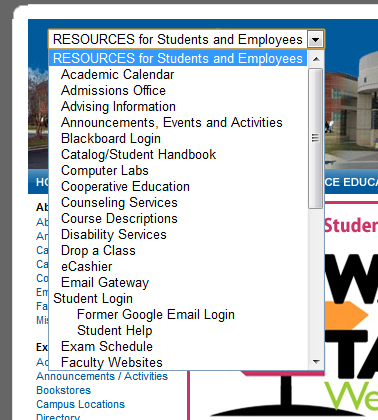I am a web designer/developer and an anthropologist. Anthropology is my first and true love; but, at this stage in my career, it doesn’t do much to help me pay the bills on its own. So, after finishing my master’s course work I got a job as a web designer based on skills I picked up doing web design as a hobby. However, I do not see my detour into web design between my master’s and my doctorate as a step away from anthropology. Anthropology informs my design work and in my short career in web design I have conducted several ethnographic studies of the user groups I build for.
My professional web design career has been solely within academic settings, currently at Rowan-Cabarrus Community College as the college webmaster. So, my experiences and observations are closely tied to this community. Outside of web design, I have worked in a wide array of fields from manufacturing to retail to education. Colleges and universities are not like any other environment I have worked in. They work by a different set of rules, with different goals and ethics. For that reason, what I write here should be understood to be situated in this context only.
This post is the second in a series about web design and anthropology – what I have learned and how I marry the two.
Intimacy and the Internet
Using the internet is an individual activity. We may be highly social online and occasionally we may sit side by side with a friend to share a cute video of a cat. However, most of the time we spend on the internet is spent physically alone. Therefore, the time we spend on a website becomes a personal and private experience. When my users are on the Internet they very rarely think about all of the technology and people that can and do watch what they do. When they discover – or are reminded – that what they do is not private they feel violated. Knowing that someone can track one’s movements online invokes feelings of violation just as sharp as if the watcher were physically present, lurking behind the user while they surfed the internet. This intimacy and feeling of privacy makes the user’s experience of the Internet much different from designers, developers and content owners.
Behavior
When we have an audience we act differently than we would do without one. When we are around other people, we both consciously and unconsciously represent ourselves with everything we do. The people around us provide feedback on that representation that can embolden or discourage us. Because of this cycle of representation and feedback or judgement, we behave in ways to elicit responses that serve our goals and projects, such as getting positive reinforcement of our self images, shocking people into viewing us as different, or trying to blend into obscurity.
Without that audience, we are still heavily influenced by the things we think others will think or say about us; however, when we believe ourselves to be in a private setting, we may take risks and experiment in ways we might not otherwise. For example, being a woman who wears a size 18 dress, I am unlikely to walk into an expensive clothing store that caters to women sized 4-6 and browse the racks, no matter how much I like the clothes or if the store has a few 18s in the back. Mostly, because of my fear that others might think I am “in the wrong place” and because, when I am shopping, I want the forefront of my identity to be my style, not my size. Online, however, I peruse the websites of these same stores frequently to get style ideas and to shop for those few larger sizes. When no one is watching, I enjoy it because I don’t have to think about how I am representing myself or how others are representing me.
In the realm of higher education, this is most readily apparent in asking “stupid” questions. Students are more likely to seek answers to “stupid” questions – questions they think are obvious or would display their ignorance – when they are online than they are in person. A student standing at the front of a line at the student services desk may feel stupid or embarrassed to say “I can’t afford my tuition, what do I do?” or “What’s a catalog?” However, when in the private setting of browsing the college website, the student feels secure enough to ask these questions to a search box. College staffers would welcome these questions from students and fully understand that the jargon of college can be difficult for new and seasoned students. However, the public setting of standing at the service desk and working with a person changes the behavior of the student because of their personal expectations and fears, no matter how inviting, sympathetic or encouraging the atmosphere and staffers are. Each student, of course, has different levels and types of comforts and anxieties with these situations. However, I would argue that even the most secure student still takes more risks in private than in public.
I have also found that users do not feel obligated to stick to the portion of the website branded for them. When I first started at my current job, I conducted a study to test how people used various navigation bars to help me build a more usable navigation system. I built a webpage that tracked their mouse movements, their hesitations and their clicks while trying to find information using the navigation bar. I also watched a portion of the users in person and conducted semi-formal interviews with them about their experiences.
One of the most popular schemes for navigation in higher education is the user role model1. These are the navigations with top level categories based on who you are, such as current student, prospective student, faculty, staff or alumni. What I learned from tracking how people used this navigation style was that no matter how the user identified themselves in the beginning, they used the entire navigation system, not just the menu built for them. Even though all of the information they were asked to seek could be found using the portion of the navigation built for them.
These people rarely reported that they looked for information outside of their branded areas while on campus. Faculty went to the academic programs office, staff went to the human resources department, and students went to student services. However, in testing, these user groups browsed all of these areas when looking for information about the college. One student that I interviewed explained, “I would not go to an employee area on campus because I might get in trouble, but online no one is watching so I can go anywhere I want, wherever I think I will find what I am looking for.” This behavior combined with the longer than usual times for finding information, caused me to throw out this navigation for one that was more meaningful to the situation.
Experience
Users create a personal, intimate relationship with websites, especially with websites they visit often, like their college’s website. When most people in higher education think about users, they think about the hundreds of people who are simultaneously on their website at any given time. From their perspective, this is not much different from the services desks on campus; there is one person helping a line of people. Thus, they think about how to write content and create designs that can serve many people at once.
Students, however, do not have this experience with the college website. For the student it is a one-on-one experience. They are alone with the website. It is more like a student meeting individually in a closed office with a counselor everyday for the duration of their college career than the experience of walking up to a service desk. So, students develop a personal relationship with the design, content and structure.
One of the best examples of this came from a series of interviews and surveys I completed shortly after starting my job at Rowan-Cabarrus. Our students claimed ownership of the college website. Students said that they wanted to see their style reflected there and they wanted content to reflect them. This seems like an obvious statement, however, in higher education, it is common practice to have both internal faculty and staff content mixed with student information. At Rowan-Cabarrus, for example, our old website had a drop down box with quick links. These quick links contained both employee links and student links. This was the most cited violation of student space in interviews and surveys. Students also complained about having information directed toward faculty advisors mixed with information for students attempting to do their own registration along with many other instances of mixed internal and external content.
Students who spent a great amount of time on the website were not thinking about all of the different types of users on the website or the volume of traffic. They were thinking about their personal experience. From the designer and content owner perspective, it makes perfect sense to have all of the content on a particular subject together. Just like an in-person service desk it would be unlikely to bother anyone to have multiple handouts on how to reset your campus password for each group. However, when you think about the context as being private and intimate, the displaying of internal information suddenly becomes more like an employee busting into a closed door session with an advisor every few minutes asking for information.
Going Forward
As a designer, developer and content owner, I have only just scratched the surface with how this should impact my work. It is not easy to shift ones’s viewpoint or to take the time amid so many other responsibilities to implement these changes. However, I have found that each project I tackle with this perspective in mind has seen more positive feedback from users than those before.
1 This scheme has fallen out of favor with many of the top universities and college in recent years but is still very popular among the middle and lower tiers of colleges and universities.



